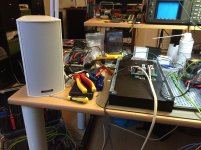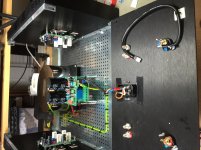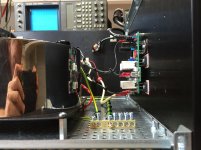numbers:
LTP with a thermally coupled pair using an AC coupled topology can achieve better than ±2mV of off set within a couple of seconds of start up.
The DC coupled topology using two sets complementary single ended inputs does at least ±50mV from cold to fully warmed up with well matched pairs of the recommended devices. I tried 546/556 and 550/560 input sets and both behaved similarly. And even worse with poorly matched sets.
That's not opinion.
But my opinion stays the same, combining DC coupled topology with single ended results in wandering of output offset.
Andrew, I have not had your experience on any of the builds I've done - protos or final builds.
At switch on from cold, you can have up to 50mV of offset - but this rapidly reduces to 10mV (4-5 minutes), and then goes to very low single digit numbers. This is not a design flaw and is quite the norm with these amplifiers.
Anything at this level (<10mV) on a power amplifier is excellent.
Again, its not a single ended input - its fully complementary. There aren't any LTP input amps that are DC coupled without a servo that can better this for the reasons explained a few posts further up.
I am afraid your comments do not add up technically.
I am satisfied with the measurements. Drove the heatsinks to 55 degrees. No problems there. I even used compressed air to frustrate the amps temperature wise. No problems!
So now it's time for some coffee and then the assembly!
So now it's time for some coffee and then the assembly!
shorting the input gives a different output offset from an open input and with a source connected one gets an offset that is between those two extremes.
That's what I was talking about earlier.
post1919
Adding the DC blocking cap to the input removes this change of offset when trying out other equipment.
I need to add: The NX has been my main amplifier for the past 2 to 3 months.
Your source has a DC offset.
My NX amplifier is used daily and today I measured offset since it is the topic of the day. At power up the right channel offset was 26mV. After a few minutes it dropped to 5mV where it remained. The left channel offset settled out at less than 1mV.
The amplifier is DC coupled to a DAC but the DAC itself has an output capacitor. The stepped attenuator at the input of the NX is 20K and it was set about 1/3 of the way up, my normal listening volume.
The amplifier is DC coupled to a DAC but the DAC itself has an output capacitor. The stepped attenuator at the input of the NX is 20K and it was set about 1/3 of the way up, my normal listening volume.
no source connected, so you can't blame a input offset.Your source has a DC offset.
What I described is the output offset changing when the source resistance is infinity (open input) and is zero resistance (shorted input).
Attaching a source (dummy load) with an intermediate resistance, (a unbuffered vol pot, or an output stabilising 100r to 1k resistor) gives an intermediate output offset.
Those conditions have NOTHING to do with the source having an output offset. There is no source connected.
Last edited:
AndrewT, short your input and measure again.
In my Hiraga I have the same problem when input is floating.
Should be stable when warm. If not you probably have a matching issue.
In my Hiraga I have the same problem when input is floating.
Should be stable when warm. If not you probably have a matching issue.
I have already fitted the 10uF DC blocking capacitor to the input to remove the effect of variable source impedance. It also removes the output offset change if one removes the interconnect, although I generally do not hot plug.AndrewT, short your input and measure again.
In my Hiraga I have the same problem when input is floating.
Should be stable when warm. If not you probably have a matching issue.
I could open up the and internal short the input after the DC blocking capacitor, but that would be repeating what I did during the testing phase. I gave my description of what happens and when prompted for "numbers" gave them as well.
There is no "bad joint" issue. There is no "matching" issue.
You can see looking at the sch what shorting, or opening, the input does to the currents and voltages around the input stage.
Last edited:
There will always be an offset due to the input bias current flowing through the input resistor.
However, the output offset does not 'wander' all over the place as you intimate.
All my builds of the nx and sx are DC coupled and stable to the figures I quoted.
If you are using the BC5X7C as spec'd - or equivalents- the bias current is very low. Since the input is complementary, the two halves cancel so you are left with the residual bias current.
However, the output offset does not 'wander' all over the place as you intimate.
All my builds of the nx and sx are DC coupled and stable to the figures I quoted.
If you are using the BC5X7C as spec'd - or equivalents- the bias current is very low. Since the input is complementary, the two halves cancel so you are left with the residual bias current.
I hope you understand that most people do not have strong fluctuating ofset on the NX. So that is why it is suggested that you might have a matching issue.
Same with my Hiraga. I did not match the front end trannies on my first go, and ofset was all over the place. Now I matched closely, also on my NX, and no issues at all.
Just trying to help with my expierience. My knowledge does not come close to what you guys know.
Sjoerd
Same with my Hiraga. I did not match the front end trannies on my first go, and ofset was all over the place. Now I matched closely, also on my NX, and no issues at all.
Just trying to help with my expierience. My knowledge does not come close to what you guys know.
Sjoerd
SjoerdSmits,
I am no expert on any of this and it appears you are spending your time to make the wiring very neat but I would think that Bonsai would recommend that you twist many of these pairs of wires together and not run all the wires as simple single strands in parallel as you are doing. I will look and see how Bonsai responds to my post. I would especially think the power supply wiring should be done this way.
Steven
I am no expert on any of this and it appears you are spending your time to make the wiring very neat but I would think that Bonsai would recommend that you twist many of these pairs of wires together and not run all the wires as simple single strands in parallel as you are doing. I will look and see how Bonsai responds to my post. I would especially think the power supply wiring should be done this way.
Steven
Note that there is lots of space in this cabinet. No separate wires even come close to one another.
- Home
- Amplifiers
- Solid State
- SX-Amp and NX-Amp






